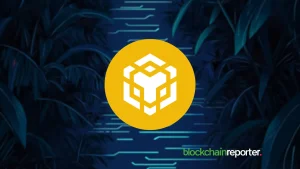
In a financial landscape that evolves with every tick of the blockchain, Zeta Markets emerges as a beacon for the DeFi community, reshaping the narrative around decentralized finance and derivatives trading. With Tristan, CEO of Zeta Markets, at the helm, this pioneering platform has quickly ascended the ranks to become a standout entity in the rapidly expanding DeFi universe.
As digital assets and blockchain technology continue to intersect with traditional financial mechanisms, Zeta Markets’ recent achievements offer a glimpse into a future where decentralization isn’t just a buzzword, but a foundational element of financial trading and investment.
In this exclusive interview, Tristan dives deep into the strategies that propelled Zeta Markets to new heights, elucidating the platform’s unique position in the derivatives volume trade and the broader DeFi space. With an eye on the horizon, Tristan also shares his vision for Zeta Markets and the broader ecosystem, highlighting the challenges and opportunities that lie ahead in the quest for a more open, efficient, and inclusive financial world.
Q1. First of all, congratulations on the remarkable growth Zeta Markets has seen recently. Can you share what strategies you believe have contributed most to this success?
Thank you, Max. Zeta has indeed reached significant milestones recently, with a daily trading volume surpassing $72 million and over 71,000 MAU. This growth stems from a combination of strategic decisions and a relentless focus on users and products. From the outset, we aimed not just to create another perps DEX but to establish the best ever, prioritizing technology, performance, and user experience, to directly challenge CEXs – which currently attract the majority of traders due to their convenience and liquidity.
As a result, Zeta stands today as the fastest perps exchange on Solana, boasting near-instant cross-chain deposits and a seamless trading experience, also from mobile. A testament to our user-centered approach has been Z-Score – Zeta’s points system – which has been instrumental in building a strong, active community by rewarding platform usage.
This system not only incentivizes trading activity but also fosters organic growth and loyalty. An exciting aspect is its role in the upcoming $Z token launch, making it an integral part of our efforts to share success with our users, empowering them as real stakeholders in the protocol. Finally, I think another crucial factor has been our steadfast belief in Solana as the only chain able to achieve DeFi mass adoption.
Despite the challenges the ecosystem has faced during the past bear market, we put our heads down and focused on refining our infrastructure, adding more features and squashing the painful bugs. Now that the Solana ecosystem has prevailed, we’ve managed to be at the forefront of the charge towards driving mass DeFi adoption.
Another driving force behind this growth has been our partners in the ecosystem including Pyth Network, BackPack, Madlads, Tensor and many others, allowing us to enhance our offerings and contribute positively to the broader Solana space, creating a virtuous cycle of growth and innovation.
Q2. With nearly $72 million in derivatives volume traded on March 7th, what do you attribute to this significant increase in trading activity on Zeta Markets?
This surge stems from a dynamic interplay of current macroeconomic conditions and specific advancements within our platform. The approval of Bitcoin ETFs, paired with Bitcoin’s rally to new ATHs, has reignited interest across the crypto sector, with Solana standing out as a key player. Solana, processing more daily transactions than Ethereum and all its L2s combined, is rapidly gaining prominence, bolstered by strong user engagement metrics that extend well beyond price speculation.
In fact it’s already grabbed the number 3 spot behind BTC and ETH (excluding Tether), causing many traders to dive into $SOL and the bet on the up and coming ecosystem projects. This enthusiasm, alongside the forthcoming launch and airdrop of the $Z token has played a pivotal role in the increase in trading activity. Furthermore, we recently launched our Market Maker Incentives Program which targets institutional and algorithmic traders who are already bringing significant liquidity and trading volume to Zeta.
Q3. The total value locked in DeFi recently surpassed $80 billion. How does Zeta Markets differentiate itself in this increasingly crowded space?
We’re the fastest and, dare I say, the best perps DEX for user experience that is fully on-chain: “Perps at the Speed of Light”. Zeta offers the best of both worlds: the speed and user experience of a centralized exchange while providing full self-custody and transparency by operating on a public blockchain network.
As pioneers of the on-chain central limit order book (CLOB), where all matching engine logic is on-chain and executed by the validator network, we set a new standard. CLOBs offer traders on Zeta significantly better spreads and execution compared to AMMs. Our fully on-chain order book and support for high-frequency trading provide deep market insights and efficient asset valuation, setting us apart in a crowded market.
Moreover, Zeta features an extremely fast and intuitive trading UI on both web and mobile. Looking ahead, these offerings will be further enhanced with the launch of our V3, which will include direct fiat onramps, multi-collateral support, Zeta-Lend, lending markets and yield products. In the long term roadmap, we are looking to go as far as to build out a DeFi-optimized L2 for Solana which should help us circumvent some of the blockspace congestion issues that are currently hamstringing Solana.
Q4. Derivatives trading offers a unique set of opportunities and challenges. How does Zeta Markets address these challenges while providing value to its users?
Derivatives trading indeed poses complex challenges, particularly within the DeFi landscape. Our initial focus was on options, a notably complex and sophisticated financial product that is commonly found in TradFi circles but has yet to penetrate the crypto markets deeply. We pivoted over a year ago to focus on linear products like perpetual futures due to the inherent simplicity and product market fit we saw with the DeFi user base.
Unlike TradFi, most traders aren’t hedge fund backed by billions in AUM and hence their needs and requirements are drastically different. As a result, we’ve really focused our efforts on both the technical reliability of our margin engine and liquidation system (which is what underpins any good derivatives exchange) to make leverage accessible to users whilst managing risk appropriately to the platform. Furthermore, since derivatives are a fast moving game, we have spent a lot of time making sure our frontend is snappy and moves at the rapid pace of the markets to give these traders the best possible experience.
Q5. Can you discuss any upcoming features or products that Zeta Markets plans to introduce to enhance user experience and liquidity on the platform?
As mentioned, enhancing liquidity on Zeta has always been a top priority as poor liquidity is often the bane of most DeFi platforms. The launch of our Maker Incentives Program marked a significant leap forward, initiating a powerful flywheel for liquidity by rewarding tight spreads and lots of depth on our orderbooks. This is critical because in any 2-sided market being able to bootstrap adoption is always a chicken and egg problem, and we’ve decided to focus on the supply-side first.
Looking ahead, we’re already working on Zeta V3. This update will introduce several new features and improvements, ensuring Zeta remains at the forefront of perps innovation. V3 will be the Zeta Markets users know and love but enhanced with brand new features such as multi-collateral support (i.e. SOL, xSOL as well as USDC collateral) and passive yield products via Zeta-Lend.
It will also focus on reducing barriers to entry for new users with abstracted wallet and direct fiat on-ramping solutions, allowing users to start trading on Zeta swiftly, even without prior Solana wallet or on-chain funds. These initiatives are part of our broader goal to create the most user-friendly and efficient trading platform in DeFi and beyond.
Q6. Regulatory concerns are a significant part of the conversation around DeFi. How is Zeta Markets navigating the regulatory landscape, and what steps are you taking to ensure compliance and security for your users?
At Zeta, security is our top priority. We’ve established advanced security mechanisms such as an insurance fund, along with global OI and withdrawal rate limits, to ward off malicious exploits. This commitment to security is evidenced by our clean track record: no smart contract exploits in over three years of operation.
For the forthcoming V3, we’re undertaking a smart contract rewrite, complemented by a meticulously planned re-audit designed to enhance both execution speed and security levels. Users at Zeta enjoy full control and self-custody of their funds, being able to deposit/withdraw at their convenience.
In light of the rapidly evolving regulatory landscape in crypto, we engage experienced legal professionals to help us ensure our operations remain in compliance with current and future regulatory requirements. As part of our commitment to regulatory adherence, we implement rigorous geoblocking measures to align with prevailing regulations and exclude operations in jurisdictions that are considered high-risk or sanctioned.
Q7. The integration of blockchain technology and traditional finance is still in its early stages. How do you see this relationship evolving, and what role will Zeta Markets play in it?
The convergence of blockchain technology with traditional finance is inevitable. In my view it’s only natural that the outdated technology that powers the legacy financial industry will have to be replaced by infrastructure that is built for the internet age. Current Fintech doesn’t exactly solve the issue, since it’s mostly a pretty UI wrapper over slow, outdated and bloated banking payment networks for example.
To get a true order of magnitude improvement, there needs to be a ground-up rethink of the system, and that’s what I believe DeFi offers. For example, Zeta takes the typical exchange, custodian, clearinghouse, prime brokerage etc. and compresses all of these services into one set of smart contracts. Now we have a more efficient stack that all speaks the same language, meaning less inefficiency, fewer middlemen and fewer fees.
Furthermore, your funds are secured by code, not humans which is deterministic and auditable. This is in stark contrast to TradFi and centralized crypto finance which has been marred by bank runs, financial crises and exchange meltdowns. We saw this in full effect during the FTX meltdown when centralized lenders all imploded due to bad debt and nefarious business practices, whilst permissionless and predictable DeFi performed as it was asked to, managing risk and liquidations in a stable manner.
Q8. Customer trust is crucial in the financial market. How does Zeta Markets build and maintain trust with its users, especially in the volatile DeFi market?
Firstly, Zeta operates as a non-custodial platform, ensuring that users maintain complete control over their assets at all times when engaging with our platform. Our fully on-chain order book enhances transparency, allowing every transaction to be visible and permanently recorded on Solana. Furthermore, Zeta’s track record of resilience, along with our consistent delivery of our vision and roadmap, plays a crucial role in building trust.
We are committed to maintaining an ongoing dialogue with our community, with transparency being one of our fundamental values. Reputable investors such as Jump, Electric Capital, and Solana Ventures have significantly aided in establishing our credibility. Finally, there’s our commitment to being a responsible participant in the Solana ecosystem and the broader DeFi space. We are here for the long run.
Q9. The concept of decentralized finance is revolutionary, yet it remains complex and unfamiliar to many. How is Zeta Markets working to demystify DeFi for the broader public?
Demystifying DeFi for the broader public is essential to our mission. We started Zeta basically because we were power users of Eth DeFi platforms and found them so painful and expensive to use that we basically told ourselves it was crazy to not be building something better. For the most part, intricate technical aspects of DeFi should remain “under the hood” – accessible yet unseen by the average user. You don’t need to be a blockchain expert; Zeta significantly brings down the barrier to entry for new traders.
Our platform operates as seamlessly and intuitively as any CEX trading UI, whilst bringing all the advantages of a DEX. Plus, it boasts exceptional speed and it’s just cheap, courtesy of Solana’s architecture, which makes the experience less jarring to people unfamiliar with the costs and slowness of typical DeFi platforms. We also try to always play a part in education, with guides and other content providing a way for users to hone their skills and bridge gaps in their understanding.
Q10. Looking ahead, what are the biggest challenges and opportunities you foresee for Zeta Markets and the DeFi ecosystem as a whole?
For DeFi to supplant centralized entities and traditional finance, merely promoting the decentralization narrative – despite its groundbreaking potential – is insufficient. Mass adoption will not happen if it comes at the expense of a poor user experience. The DeFi ecosystem must persist in refining user experiences to equal or surpass those provided by centralized entities and traditional finance.
This is core to our values and why we landed on Solana. Many DeFi projects tend to over-engineer their products and mechanisms, resulting in complexity that is inaccessible to many and presents onboarding challenges. This situation serves as a reminder for Zeta to remain fundamentally user-centric, prioritizing the creation of the best trading experience and the elimination of user friction throughout their journey, always paying close attention to user feedback.
In addition, we emphasize the value shared with our community, through our upcoming native token which will enable staking and governance, along with various initiatives such as maker incentive program, ambassador program, and referrals.
Q11. Finally, what advice would you give to someone looking to enter the DeFi space, either as an investor or as an entrepreneur?
For those entering DeFi as an investor, my primary recommendation is to rigorously adhere to the “Do Your Own Research” (DYOR) principle. Engaging with DeFi protocols and products necessitates conducting in-depth research and understanding the inherent risks. Entrepreneurs should focus on solving real problems and maintain close communication with the community and users of their products.
The collaborative nature of the DeFi space often means that success results from cooperative development rather than solitary efforts. Remaining flexible and receptive to feedback is crucial, as the DeFi landscape is constantly evolving. Lastly, I would earnestly encourage developers from various ecosystems to explore Solana. It’s an incredibly exciting time for the ecosystem, with a wealth of innovations and opportunities available, along with developer tooling that has improved in leaps and bounds since we first started.
Interview Summary
As we conclude this deep dive into the heart of Zeta Markets and the visionary perspective of its CEO, Tristan, it’s clear that the journey of DeFi and derivatives trading is just beginning. Through innovation, user-centric design, and an unwavering commitment to security and transparency, Zeta Markets stands as a testament to the transformative power of decentralized finance.
Tristan’s insights offer not only a window into the strategies driving Zeta Markets’ remarkable growth but also a roadmap for the future of finance—a world where efficiency, inclusivity, and user empowerment are not aspirational goals but foundational elements. As the DeFi space continues to evolve, Zeta Markets’ forward-looking approach and dedication to community and collaboration set a benchmark for others to follow.









